Also published in Shapeways Magazine
—–
I usually start my designs by prototyping at home with a desktop FDM/filament 3D printer. But some models are really, really difficult to print on a filament-based 3D printer, and my “Fidget Cube” model is one of the worst: it has enclosed hinges that point in every possible direction, and pieces of the model that have to somehow print floating right above other pieces. On an SLS/nylon powder printer like those used for Strong & Flexible plastic prints at Shapeways, such “impossible” prints can be printed with great success rates. But at home, different desktop filament printers, different filaments, and seemingly even different days of the week can have an influence on the success or failure of 3D printing Fidget Cubes.
In this post, we’ll track the evolution of one particularly fidgety 3D design over the past five years, from an assembly model to print-in-place on FDM machines, to multicolor variants, and finally all the way to SLS printing at Shapeways, where we will be able to level up our idea of “impossible” to include 3D printing a fully-functioning Yoshimoto cube!

2013: Pieces
Our story begins with a 3D-printable Folding Cube by the legendary emmett. This model prints in eight separate pieces which you then click together to assemble.
This model is based on the popular “photo cubes” that you might have made out of paper and tape when you were younger. If you want to make a paper one, check out Magic Folding Photo Cubes on Instructables. Emmett’s Folding Cube is a beautiful model that is really fun to fidget with, but because I’m not good at rotating or visualizing objects mentally, I had a really difficult time putting the pieces together properly. In fact, I was so bad at it that I vowed never to do it again, and set about to create a remix that could print all in one piece, fully assembled.
2014: Print in Place
After a lot of trial and error, I ended up creating the design from scratch in OpenSCAD. Clearances between hinge parts and adjacent surfaces have to be just right for the Print-in-Place Fidget Cube to print successfully, and getting your slicer settings and model clearances to hit that sweet spot is a fairly advanced 3D printing challenge.
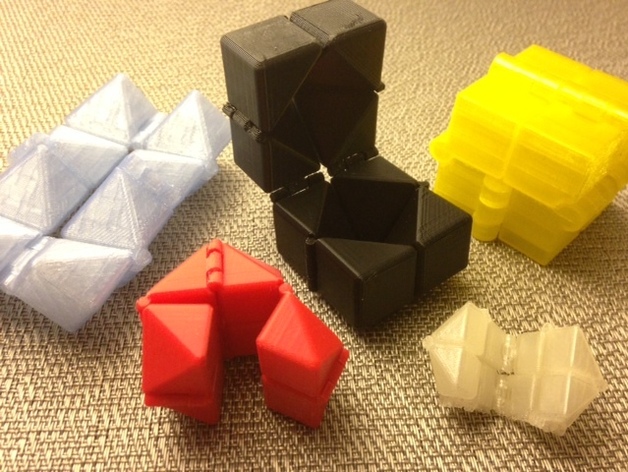
It probably isn’t going to work on your printer, with your filament, on the first try, but once you find the right settings and clearances you should be able to print these Fidget Cubes reliably with a low failure rate (or, you can obviously go straight to Shapeways). If you decide to print it at home, the Print-in-Place Fidget Cube model we put on Thingiverse is customizable so that you can tweak sizes and clearances and try to find what works for your machine.
2015: Yoshimoto
The folding action of the Fidget Cube is the same as that of the Yoshimoto Cube, an incredible model that takes advantage of the fact that a cube can be evenly dissected into two Stellated Rhombic Dodecahedra — and in fact, that those two Stellated Rhombic Dodecahedra can themselves be folded inside out to form cubes of the same size as the original cube. You kind of have to see it to believe it:
You can make a Yoshimoto Cube using origami or you can purchase a truly beautiful version from the MoMA store, or get this Magic Star from Amazon. Unfortunately, you can’t make a Yoshimoto Cube by carving up a Fidget Cube into two pieces, because the hinges protrude out of the shape and would interfere with the nesting of the pieces. However, we can carve out a Stellated Rhombic Dodecahadon shape from the inside of our fidget cube to form a Fidget Star that folds one way into a cube and the other way into a Stellated Rhombic Dodecahedron.
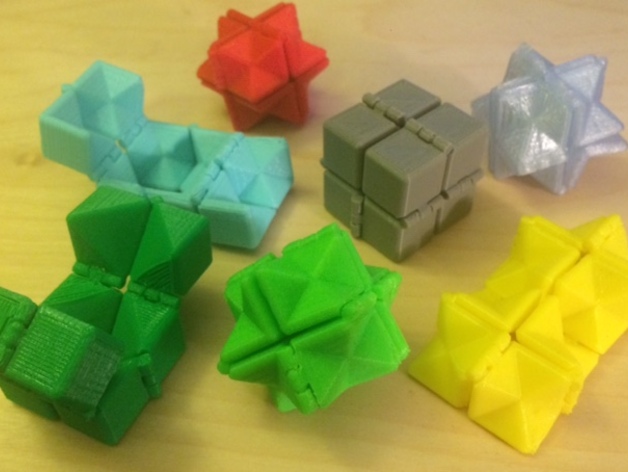
Here it is in action. This piece isn’t any more difficult to print than the Fidget Cube, but it seems a lot more impressive and surprising when the entire shape of the object changes as it turns inside out.
2016: Embedded Hinges
Next in line is the Kobayashi Fidget Cube by pkobayashi, which prints in one piece and has flat hinges! I think you still couldn’t make a good Yoshimoto Cube out of this, but this version should be much, much easier to print than the Fidget Cube. This design isn’t a remix of mine or of emmett’s, but it is definitely an improvement on both:
Designer pkobayashi later created a Dual Color version, which you print in pieces and then assemble:
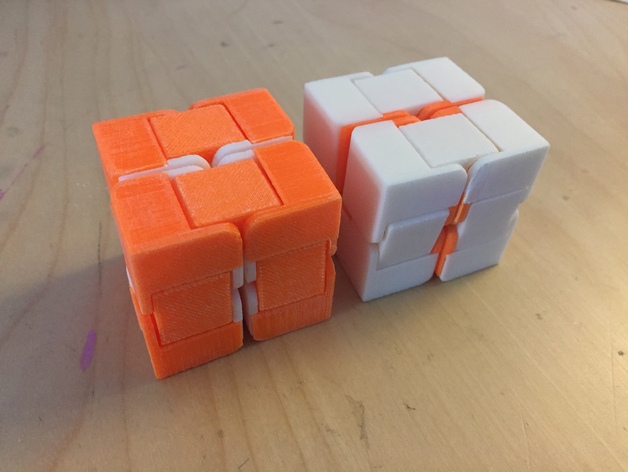
2017: Multicolor
What about two-color print-in-place cubes? As of this year, that also exists. MosaicManufacturing has been making beautiful Multi-Color Fidget Star prints! Design-wise, this was made from the Fidget Star just by splitting the model into two pieces (a cube surrounded by a shell). But, printing it is a serious accomplishment:
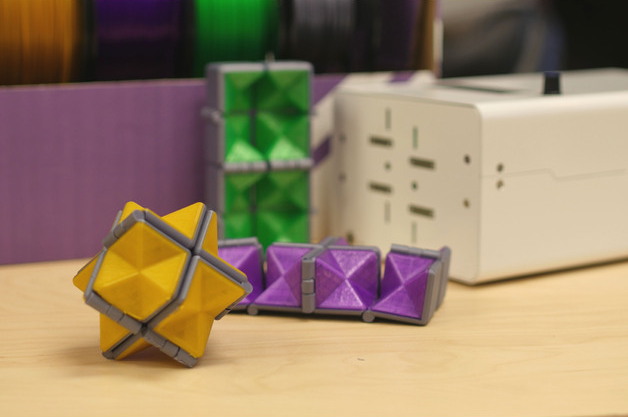
They made me one, and it’s huge! Thank you, Mosiac Manufacturing!!
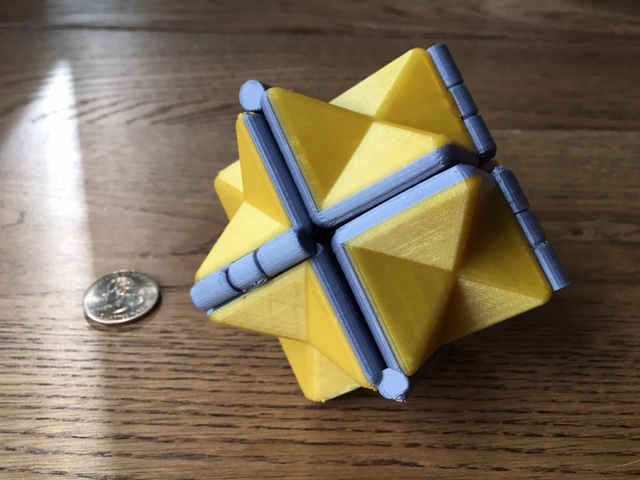
They handled the two-color printing with a Palette, a device you can use for pre-processing filament to send to your 3D printer. The Palette actually cuts and assembles pieces of colored filament at exactly the right lengths for switching colors in the correct places while printing.
If you have a dual-nozzle 3D printer then you can download Mosaic Manufacturing’s Multi-Color Fidget Star model and print it yourself. Here is one I printed on the lovely dual-nozzle Ultimaker 3. I happened to print it very small, and on fast, low-res “draft” mode, so it’s nowhere near the highest quality that the Ultimaker 3 can produce, but it still looks pretty good and it works!
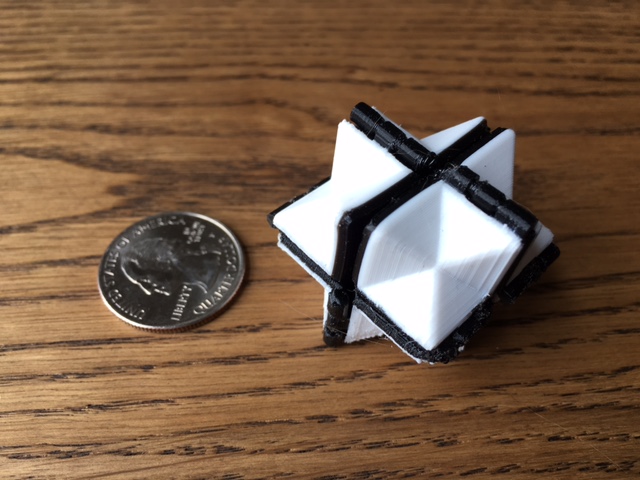
… And Beyond: Shapeways!
Printing any of the Fidget Cubes above on an FDM printer can be a difficult process that involves a lot of trial and error, skill, and luck. A lot of the problem lies with the fact that the model has to print without support material for the hinges to operate, which means that the many overhangs and bridges on the model have to print without that support. These problems melt away if you print with a “powder printer” such as the SLS Nylon printers they use at Shapeways to print in Strong & Flexible plastic:
Having industrial-grade 3D printers makes a huge difference in what you can print successfully. Here’s a wonderful, tiny Fidget Cube Stress Reliever by brandutchmen on Shapeways:
Even better, with the SLS printers, we can get to the holy grail of Fidget Cubes: Nesting hinged models that combine to make a Yoshimoto Cube! VeryWetPaint created a fully functional, two-piece, nesting Yoshimoto Cube model that prints in SLS Nylon at Shapeways, called the Yoshi prime box. His open-style design very cleverly allows both pieces to be hinged so that they can nest together. It’s amazing!
Shapeways people, what’s next? Can you push this design to the next level? What even is the next level? Let us know in the comments and we’ll see which designers dare to take fidgeting to new heights…
——————
As an Amazon Associate we earn from qualifying purchases, so if you’ve got something you need to pick up anyway, going to Amazon through this link will help us keep Hacktastic running. Thanks! :)



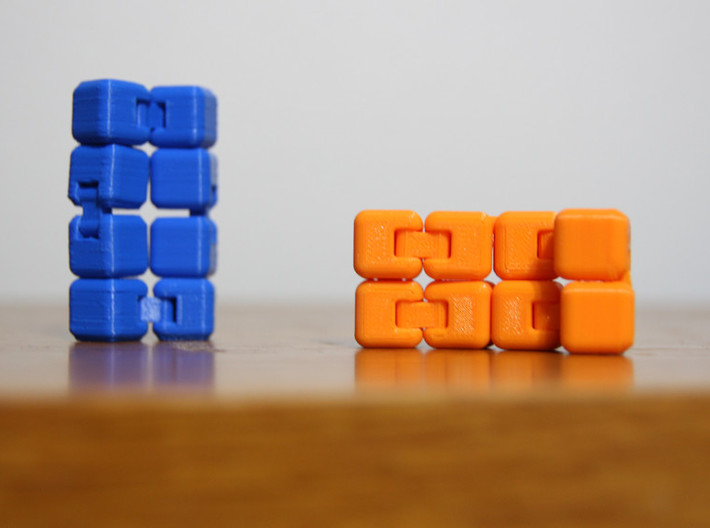

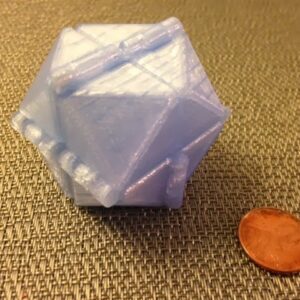
Leave a Reply